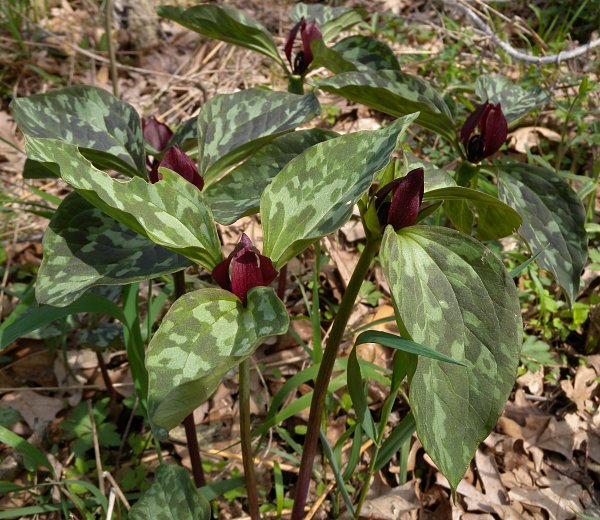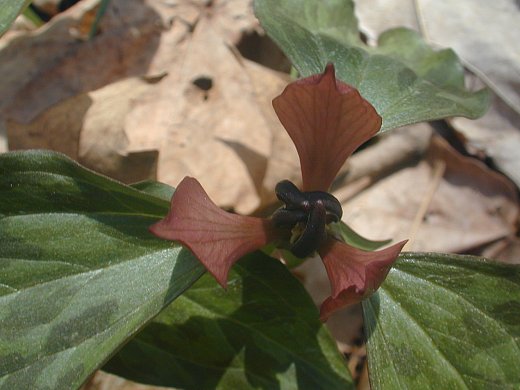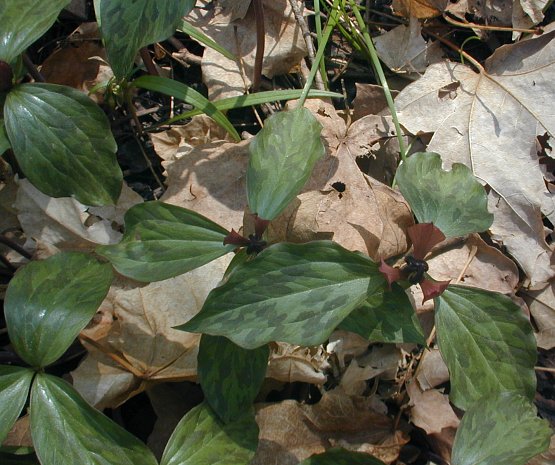Description: This herbaceous perennial plant is ½-1¼' tall and unbranched. The erect central stem is light green to reddish purple, terete, rather stout, and glabrous. At the apex of this stem, there are 3 spreading leaves surrounding a single sessile flower. Immature plants, however, produce only leaves without the flower. The leaves are 3-6" long and 1½-3½" across; they are ovate in shape and smooth along their margins, tapering into distinct petioles. The upper leaf surface is medium green and heavily mottled with patches of light green and dark green; it is glabrous. The lower leaf surface is pale green and unmottled; it is also glabrous. On rare occasions, some plants will have leaves with solid green upper surfaces. Leaf venation is parallel with occasional interconnecting secondary veins.

The flower has 3 maroon petals, 3 green sepals, 6 stamens with long black anthers, and an ovary with 3 stigmata. The petals are 1–1¼" long and rhombic-elliptic in shape; they curve inward toward their tips. The sepals are ¾–1" long, lanceolate-triangular in shape, and smooth along their often purplish margins; they hang downward from the base of the flower. The stamens are about ½" long, curving inward toward the other stamens. The blooming period is mid- to late spring, lasting about 3-4 weeks. Individual flowers are relatively long-lived. There is no noticeable floral scent. Afterwards, each flower is replaced by a single fruit (technically a berry). These fruits are a little less than ½" (10 mm.) long, rhomboid-ovoid in shape, 6-angled, and pale green to purplish green. Each fruit contains several small seeds; they are dark brown with white food appendages. The main rootstock is thickened and elongated, with numerous feeder roots. Rhizomes are also produced, causing this plant to form clonal colonies.

Cultivation:
The
preference is medium shade to dappled sunlight, moist to dry-mesic
conditions, and soil containing loam or clay-loam. The foliage is
rarely bothered by
pests or disease. Trilliums are slow to develop because of the short
period of active growth during the spring, and up to 10 years may be
required before a plant reaches flowering size in the wild.
Range & Habitat:
The native Prairie Trillium is a common plant that occurs in every
county of Illinois (see Distribution
Map). It is found primarily in rich woodlands, open
woodlands, and savannas, where deciduous trees are dominant (including
oak-hickory woodlands and maple-dominated woodlands). Sometimes this
species survives degradation of woodland habitats, and it can be found
along fence rows with woody vegetation, overgrown areas near railroads,
and miscellaneous waste areas with partial or light shade.

Faunal Associations: The maroon flowers of the Prairie Trillium may attract carrion beetles and flesh flies, although little is known about the insect pollinators of this trillium (Trillium sp.) because floral visitors are rare. Only pollen is available as a floral reward. The caterpillars of two polyphagous moths, Clepsis melaleucana (Black-patched Clepsis) and Euplexia benesimilis (American Angle Shades) feed on trilliums (Covell, 1984/2005). The seeds of these plants are often distributed by ants because of their food appendages. Among mammalian herbivores, White-tailed Deer are especially known to eat the flowers and foliage of trilliums. There is also some evidence that the seeds of trilliums can pass through their digestive tracts and remain viable. Therefore, White-tailed Deer may help to distribute the seeds across long distances (Vellend et al., 2003). Where White-tailed Deer are too abundant, however, they may destroy local populations of these plants. It is possible that the mottled pattern of the foliage of the Prairie Trillium is an adaptation to deer predation as this type of pattern may help to camoflage the plant with the surrounding forest floor.

Photographic
Location:
A mesic woodland at Busey Woods in Urbana, Illinois, and an
upland savanna in McLean County, Illinois.
Comments:
The common name is misleading because the Prairie Trillium occurs in
woodlands like other trilliums (Trillium
spp.), rather than prairies. However, it is especially
common in Illinois and the surrounding states where prairies occur.
This trillium species is relatively easy to identify for the following
reasons: 1) its sepals hang downward from the flower, whereas in other Trillium
spp. the sepals are usually spreading to ascending; 2) its
flowers are sessile against the central stem and leaves,
whereas the flowers of some trilliums (e.g., Trillium erectum)
are held above the foliage
on short stalks; and 3) the leaves taper gradually at their bases into
short petioles, whereas the leaves of some trilliums are sessile
and quite rounded at their bases. There are different forms of the
Prairie Trillium that have yellow or
maroon flowers, yellow or black anthers, and mottled or solid green
leaves. The form described here, Trillium
recurvatum recurvatum, is by far the most common.